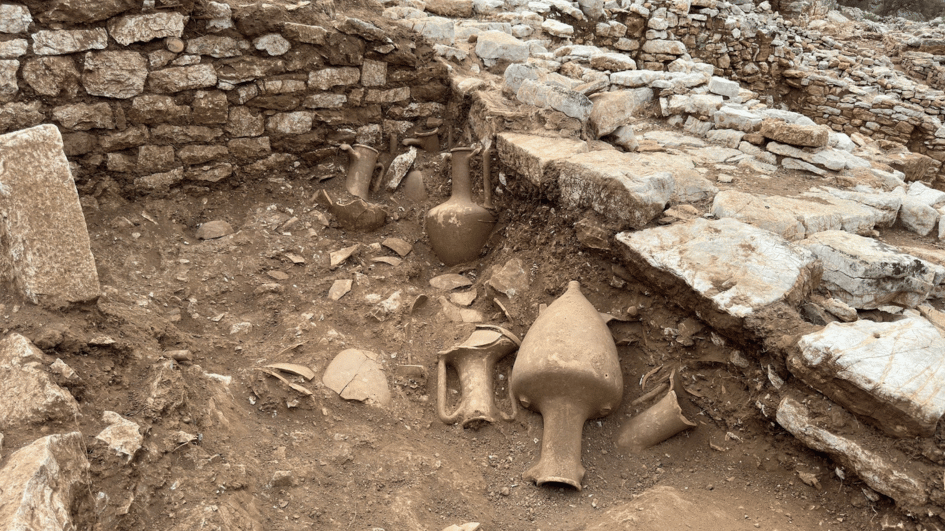Exciting discovery in Amos ancient city
MUĞLA

In a new discovery made during ongoing excavations in the ancient city of Amos, which has a history of nearly 3,000 years and is famous for its rich cultural heritage in the western town of Marmaris, 10 amphorae (vessels with vertical handles) have come to light.
The amphorae, one of which was found intact and the others in pieces, date back to the 2nd century B.C. and they are Rhodes amphorae, officials reported.
The surface research works in Amos that started in 2019 under the chairmanship of Associate Professor Mehmet Gürbüzer from Muğla Sıtkı Koçman University's (MSKÜ) Archaeology Department gained excavation status the previous year.
During the excavations in the ancient city, a structure called "thermopolium" in ancient times, which had the same function as today's restaurants, was discovered just to the east of the city theater, and a section that was thought to have been used as a storage area for the restaurant. The 10 amphorae were unearthed near the surface in this area.
Gürbüzer said that this new discovery in Amos shows that the excavations will continue for a long time.
“We have come a long way in the fifth year of the work since 2019. The amphorae we found during the latest excavations indicate that there were food and beverage areas around the theater in the ancient city. Moreover, the amphorae we found are very close to the surface and they did not get much damage. I believe that we will be able to reveal the true face of the ancient city of Amos during excavations that will continue in the coming years, too,” he said.
Marmaris Chamber of Commerce President Mutlu Ayhan expressed his excitement about the newly found amphorae and said, "We have made significant progress in the excavations that have lasted five years. Teams discover a new place in the city every year. In addition to the previously unearthed necropolis, temple and agora stairs, the stage building was unearthed this year. Finally, we were very excited about the amphorae found in an ancient cellar.”
Stating that Amos is a valuable treasure for Marmaris with its thousands of years of history, Marmaris Mayor Mehmet Oktay said, “We have been following the works carried out in Amos for five years with great curiosity. We are excited every time that new finds come to light during excavations and we learn new information about Amos. When the work in this ancient city next to Marmaris is finished, we will have an important spot for culture and art tourism.”
‘Goddess Temple’
One of the most important cities of the Union of Rhodes, Amos means “the Goddess Temple” in a dialect of Ancient Greek.
Known as Samnaios in the Hellenistic era, Apollon was considered the leading god of the city.
The city is surrounded by 1.8-meter-thick and 3.5-meter-high walls and towers. The city, whose most important surviving structure is a theater, survived through the Hellenistic era until the Eastern Roman era.
The ancient city also has terraces where the coves around the area can be seen, together with the sunrise and sunset.
Rental agreements from the second century B.C., which were unearthed during excavations in 1948 by Professor George Ewart Bean, show that Amos’ history dates back to 2,200 years.
The ancient city was declared a first-degree archaeological site on Oct. 14, 1978.
















